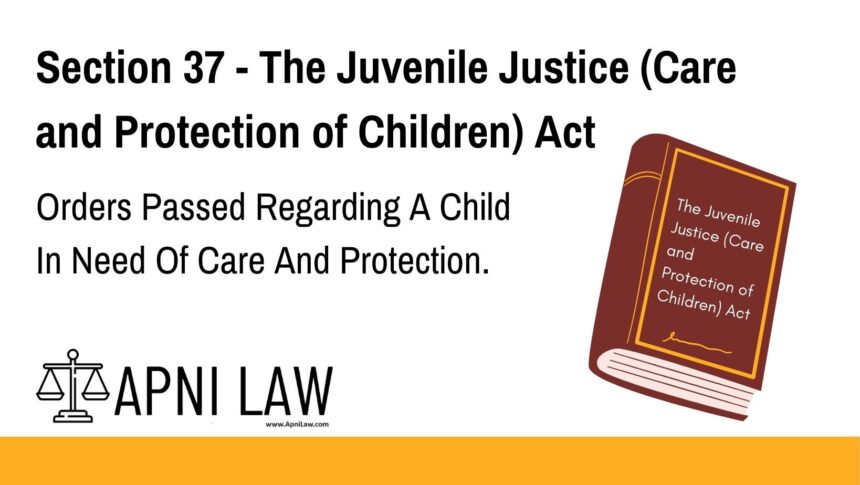Code
(1) The Committee on being satisfied through the inquiry that the child before the Committee is a child in need of care and protection, may, on consideration of Social Investigation Report and taking into account the child’s wishes in case the child is sufficiently mature to take a view, pass one or more of the following orders, namely:—
(a) declaration that a child is in need of care and protection;
(b) restoration of the child to parents or guardian or family with or without supervision of Child Welfare Officer or designated social worker;
(c) placement of the child in Children’s Home or fit facility or Specialised Adoption Agency for the purpose of adoption for long-term or temporary care, keeping in mind the capacity of the institution for housing such children, either after reaching the conclusion that the family of the child cannot be traced or even if traced, restoration of the child to the family is not in the best interest of the child;
(d) placement of the child with fit person for long-term or temporary care;
(e) foster care orders under section 44;
(f) sponsorship orders under section 45;
(g) directions to persons or institutions or facilities in whose care the child is placed, regarding care, protection and rehabilitation of the child, including directions relating to immediate shelter and services such as medical attention, psychiatric and psychological support including need-based counselling, occupational therapy or behaviour modification therapy, skill training, legal aid, educational services, and other developmental activities, as required, as well as follow-up and coordination with the District Child Protection Unit or State Government and other agencies;
(h) declaration that the child is legally free for adoption under section 38.
(2) The Committee may also pass orders for—
(i) declaration of fit persons for foster care;
(ii) getting after care support under section 46; or
(iii) any other order related to any other function as may be prescribed.
Explanation
Section 37 of the Juvenile Justice Act empowers the Child Welfare Committee (CWC) to make crucial decisions regarding the protection, rehabilitation, and care of children identified as being in need. These decisions are based on detailed inquiries, Social Investigation Reports, and the child’s preferences when appropriate.
The law outlines various types of rehabilitative orders the Committee may issue, including restoration to family, institutional placement, adoption, foster care, sponsorship, and after-care. The Committee is also tasked with ensuring appropriate services and interventions are in place for the child’s welfare and development.
Key Highlights
-
The CWC evaluates both the Social Investigation Report and the child’s own preferences (if mature).
-
Restoration to family is prioritized but only if it serves the child’s best interests.
-
Multiple placement options: Children’s Homes, fit facilities, fit persons, or Specialized Adoption Agencies.
-
Orders can include medical, psychological, educational, and skill-based support.
-
Legal declarations for adoption and aftercare assistance can also be granted.
Illustration
Example 1: A 12-year-old girl rescued from child labor is declared a child in need of care and protection. The CWC, after evaluating the family’s inability to care for her, places her in a Children’s Home and simultaneously initiates the process for long-term adoption.
Example 2: A 10-year-old boy lost during a festival is restored to his parents after inquiry and a positive Social Investigation Report. The Committee directs a social worker to visit the home bi-weekly for 3 months.
Example 3: An orphaned child, legally declared free for adoption under Section 38, is placed in a Specialized Adoption Agency until adoption is finalized.
Frequently Asked Questions (FAQs)
Q1: What does the CWC consider before passing orders under Section 37?
A: The Committee considers the Social Investigation Report, child’s wishes (if mature), family situation, and institutional capacity.
Q2: Can a child be declared legally free for adoption through this section?
A: Yes, under clause (h), the Committee can make such a declaration following guidelines in Section 38.
Q3: What support services can be included in the orders?
A: Services such as medical care, counselling, skill training, education, therapy, and legal aid can be mandated.
Q4: Is foster care a direct option under this section?
A: Yes, foster care can be ordered under clause (e) via Section 44.
Q5: Who ensures follow-up of these orders?
A: Coordination with the District Child Protection Unit and State Government is directed under clause (g).
Conclusion
Section 37 is a foundational provision in the Juvenile Justice Act that ensures a structured, child-centric approach in deciding the future of children in distress. The provision equips the Child Welfare Committee with the necessary powers and options to tailor decisions for the best interest of each child, while also ensuring institutional accountability and oversight.
🔗 For more information on Juvenile Justice legal provisions, visit ApniLaw – Juvenile Justice Bare Act








